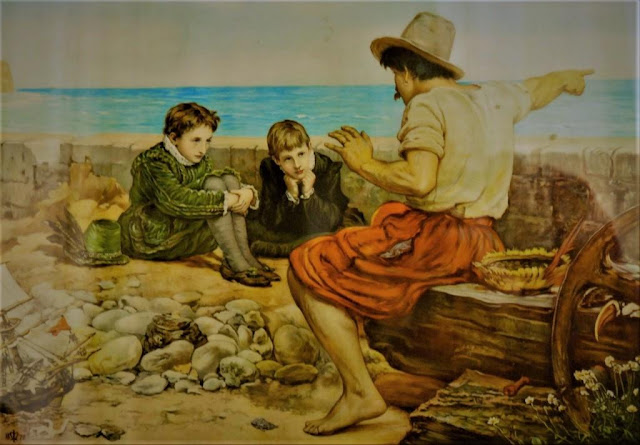Matching the Millais
As you should know by now, a famous painting will be displayed at the
museum when when Fairlynch opens its doors on 28 May for the Raleigh 400
exhibition. But it’s also being staged
on Budleigh beach.
Victorian artist Sir John Everett Millais painted his masterpiece in
1870, showing the young Walter Raleigh, the future favourite courtier of Queen
Elizabeth I, and his half-brother Humphrey Gilbert listening to a sailor’s
tales of exotic voyages. The painting, part of Tate Britain’s collection, will
be on display for three months until 31 August.
Sir John Everett Millais, a self-portrait, as reproduced in the
artist’s biography published by his son John Guille Millais who was also a
successful artist
Adding to celebrations on the opening day of the exhibition, members of
the town’s Art Club have set themselves the challenge of recreating the scene
painted by Millais. And a few additional characters will be making an
appearance in the tableau, including the artist with his easel, an adult Sir
Walter himself on horseback and his mother Katherine Champernowne, all in
period costume.
The
part of Katherine Champernowne will be played by Rosemary Griggs, pictured, a
retired senior civil servant who now has time to indulge a lifelong interest in
history. She regularly gives talks in costume and in character as Lady
Katherine at Compton Castle, and also talks to other groups.
Rosemary
has done much research into Katherine’s life in Devon, and her family and will
be available to chat informally with visitors to the tableau and the museum. ‘I
can also include details of my costume - people are often fascinated by it,’
she says.
The Queen Mother's carriage, surmounted by her crown,
adorned with camellias from her own gardens and draped in her personal
standard, travels down to Westminster Abbey for her funeral on 30 March 2002
Sir
Walter on horseback will be played by Rob Batson, of Budleigh Salterton Riding
School. A former captain with the King's Troop Royal Horse Artillery, in 2002, he led the guard which
escorted the coffin of the Queen Mother on the George Gun from Westminster Hall
to the service in nearby Westminster Abbey.
‘There will be reflections,’ he was quoted as saying
at the time, after the funeral of such a much-loved member of the royal
family. ‘I have some time off to get to
grips with what has happened and being part of history.’
On this occasion, for the re-creation of the
‘Boyhood’ scene, Rob Batson will be riding Doughnut, his faithful 20-year-old
mount who has the distinction of taking part in the Trooping of the
Colour.
The Budleigh Salterton event will be on a much
smaller scale, but he will again be playing a historic role. Sir Walter
Raleigh, among his many achievements and offices, was a loyal Captain of the Guard for the
first Queen Elizabeth.
Local families have been keen to respond to the challenge by providing
models for the two children in the original painting. Eleven-year-old twins Frank and Henry Southan from Budleigh Salterton
had their heads shaved last year to raise funds for cancer charity Macmillan
Cancer Support. Now the boys, pupils at
St Peter’s Church of England Primary School in Budleigh, are ready to help the
museum project by taking part in the tableau and encouraging visitors to see
the original painting at Fairlynch.
Playing the part of young Walter Raleigh, as he listens to the stories
which supposedly inspired him to found the first English-speaking colony in the
New World, will demand real acting skills, thinks Henry. ‘Lots of people will
be taking photos of the scene, so it’s important for us all to have the right
expressions,’ he points out.
Gender will not be a limiting factor in the tableau. ‘Purists might
object but I can’t see any reason why the children shouldn’t be girls, or a boy
and a girl,’ said organizer and Art Club member John Washington, who will play
the part of Millais.
Budleigh Brownies are among the local groups who have been approached
for candidates to play the part of Walter and his half-brother.
The original painting will go back to Tate Britain at the end of August,
but Fairlynch volunteers and Art Club members organizing the tableau are sure
that images of this new Raleigh-inspired masterpiece will be treasured by the
museum and by many proud parents.
A certain number of places are available for young persons aged 10-14 to
play the parts of Walter Raleigh and Humphrey Gilbert in the Raleigh Wall
tableau, from 2.00 to 4.00 pm on Monday 28 May. For further details and to book
a place please email Fairlynch Museum Trustee Michael Downes via mr.downes@gmail.com
FOR THE RALEIGH 400 CALENDAR OF




















